Madam Irene closes the door of her office and climbs the stairs. She is on her way to teach her first ever class at St Jude’s Girls’ Secondary School.
One of the youngest teachers at St Jude’s, Madam Irene is charismatic and popular amongst her students. She has a quick wit and a wisdom beyond her years.
“I’m looking forward to teaching in the new school,” she says, drinking in her surroundings. “When girls are supported, you are supporting the whole community.”
Madam Irene walks into her pristine classroom, sitting down at freshly burnished desks are 25 Form 4 girls. The walls are freshly painted, the blackboard is untouched and through the open windows is the sound of a lawn mower, chugging away.
“Welcome back from the holidays girls,” says Madam Irene. “It’s the start of a New Year! I hope you had a good rest.”
When Madam Irene was in Form 6, her year level had 480 students. Only two of these students achieved Division One exam results (the highest grade) and Madam Irene was one of them.
When she graduated from Form 6, the school asked her to come back and help out with their students. Madam Irene quickly learnt that she had a talent for teaching and went on to study at Makumira University in Arusha.
Growing up, both of Madam Irene’s parents played a pivotal role in supporting her throughout her life, with her mother being an important figure in her education.
“She brought me up to be a responsible person,” says Madam Irene. “To be confident, and to work hard, to earn what I’m supposed to earn, not to expect things to happen.”
These are lessons she hands on to her students, lessons that tie in nicely with today’s class topic.
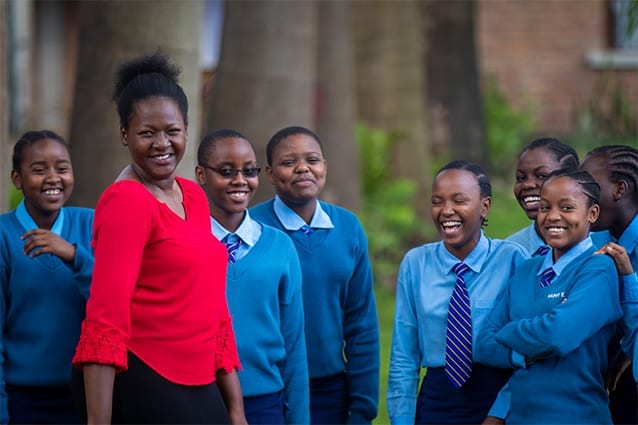
“Today we will be studying a new topic,” says Madam Irene. “Culture!”
“So, what is culture?”
The students raise their hands and offer answers.
“Culture is the way you dress.”
“Culture is the language you speak.”
“Culture is the food you eat.”
For Madam Irene and her fellow teachers, teaching at the new girls’ school is an opportunity to establish a new culture and a new beginning for these students.
There have been times in Madam Irene’s career when she has been the only woman in a room filled with men.
“Being a woman in the midst of men can be challenging,” says Madam Irene. “If I speak things, then some men will think I’m too emotional, or sometimes I’m expected to wait for men to speak first - it’s challenging.”

But Madam Irene is seeing a lot of change and women are now contributing to society in a diverse range of roles - as political leaders, in business and even driving cars, something that in the past was uncommon.
“I know there are other women behind me who are supporting me and when men see a balance of 50-50 in a room they will not look down upon me, they will see an equal.”
As a civics teacher, there will be many opportunities for Madam Irene to discuss equality with her students.
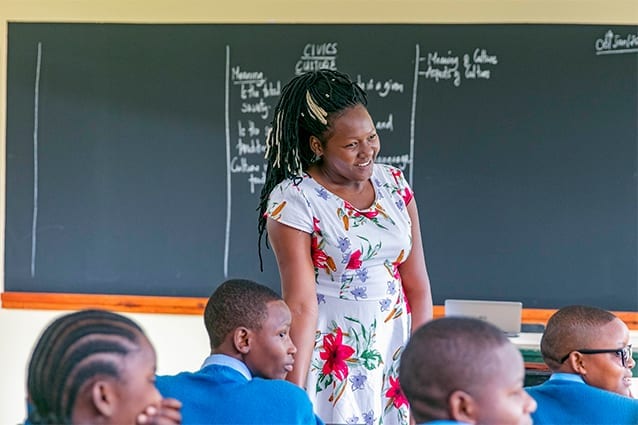
“They will get to know their rights,” she says. “For example, our constitution does not differentiate men and women – we are all equal!”
As the class moves on, the students begin talking about their tribes, comparing different handshakes. Madam Irene approaches one of the students, Susie, who is sitting by the wall.
“Susie,” says Madam Irene. “Come and show me how a woman would greet a man in your tribe.”
Madam Irene poses as a man, and Susie curtsies in front of her, offering a handshake.
“You know,” says Madam Irene. “In some tribes a woman has to kneel before reaching a man.”
As Madam Irene speaks she moves to the front of the classroom and stands proudly, knowing that she is in the privileged position of showing these students what an independent, capable woman can achieve.
Sponsor a student’s academic scholarship and support them in reaching their full potential.
The bell rings and Mr Victor Polepole ushers his Form 3 students into the Chemistry lab, waving his arms with more enthusiasm than a plane marshall at an airport – "welcome, welcome, welcome!"
Chairs screech as students assume their seats, opening their notebooks to a crisp new page. Mr Polepole, wearing a striped navy shirt, turns to write on the whiteboard.
"Today we are talking about compounds and metals," he says.
Despite this being his fourth ninety-minute lesson for the day, Mr Polepole is pulsing with energy as his marker scrawls without pause across the whiteboard.
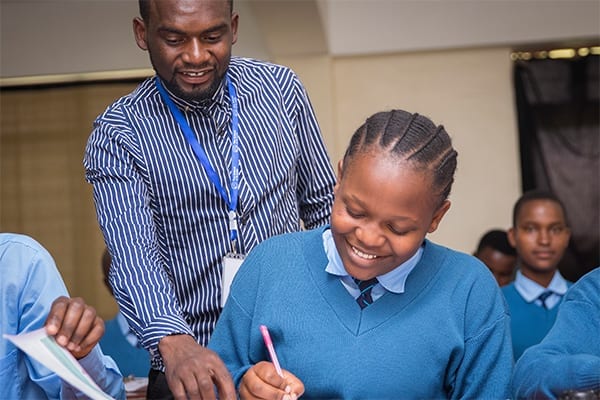
He has loved Chemistry since he was a teenager when his older sister, Riziki, would tutor him about Topic Volumetric Analysis.
In Kiswahili, ‘polepole’ means ‘slowly’ however Victor Polepole’s classes are anything but that. As he talks to his students, he bounces around the room, like a metallic ball in a pinball machine. One minute he is standing underneath a diagram of a synapse, the next he will be weaving between the students' desks, his hands a whirl of action.
"Who can tell us the meaning of the word 'metal'?" he asks the students.
The class hesitates, but Mr Polepole smiles inviting one of his students to stand and respond.
"Metal can conduct heat and electricity," says a student named Sule.
As a teacher, Mr Polepole’s approach is to be friendly believing this will encourage his pupils to open up.
"We are not the enemies of the students," laughs Mr Polepole. "Here at St Jude’s we are their friend."
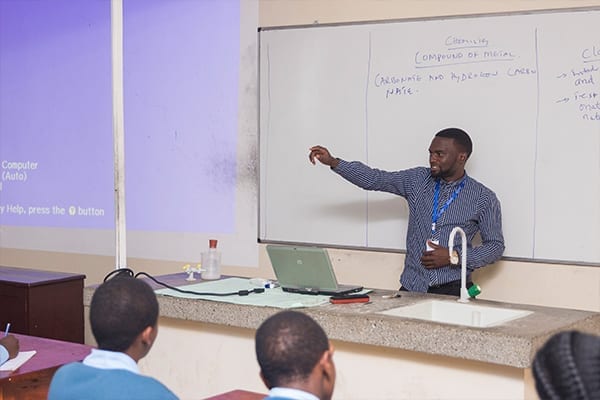
"We give the students a task to do,” he says. “But instead of using force we give them the confidence to speak, and to ask questions - to be free."
When Mr Polepole was a 13-year-old student his teacher caned his arm for not answering a question – the experience left him with scars.
"At St Jude’s we teach students without giving them corporal punishment," says Mr Polepole. "We also learn how to help students coming from a poor environment."
Since arriving at St Jude’s in 2015, Mr Polepole has quickly gained a reputation as one of the school’s finest teachers.
"He’s the best Chemistry teacher in our school," says Form 3 student, Abbas. "He knows how to prepare us for the national exams."
In 2017, Mr Polepole’s Form 4 class climbed into the top ten in the country for Chemistry. In recognition of this achievement, School Founder Gemma Sisia presented him with a goat at school assembly, a tradition in Tanzania.

He keeps photos from this day on his laptop and considers it the proudest day of his teaching career.
As Mr Polepole continues to ping around the classroom, the students remain hunched over their books, elbows out, taking notes relentlessly.
Mr Polepole is delighted to discover that one of his students has the surname “Aluminate” – which is a chemical compound.
He rushes to the whiteboard, pointing to a list of compounds.
"Would you name your children after any of these?" he asks the students jokingly, with a toothy grin.
The students debate which compound they would choose; Mr Polepole, on the other hand, has already made up his mind.
"If I have a son or daughter," he says. "I think I will name them after Zincate."
Without dedicated teachers, our students wouldn’t get the quality education they need to become the future engineers and doctors they dream of being. Your donations make this possible, donate today.
“Good afternoon, Mr Kephas!” sing 25 seven-year-old students as one. They are sitting in the shape of a horseshoe, their feet dangling from wooden benches, not quite touching the ground.
Mr Khepas breezes into the classroom, laughing, his arms spread wide. He is wearing a suit, with a light blue shirt and polished shoes. This is an unusual outfit for an art teacher.
“People wearing suits are usually lawyers or accountants,” he says. “But as an artist, you can wear a suit.”
Surrounding him is his Standard 2 class for the afternoon.
“What will we be doing today?” asks Mr Kephas, holding up a piece of paper with an outline of a shirt sketched onto it, as a clue.
The students rush to answer, eager to impress the popular Mr Kephas.
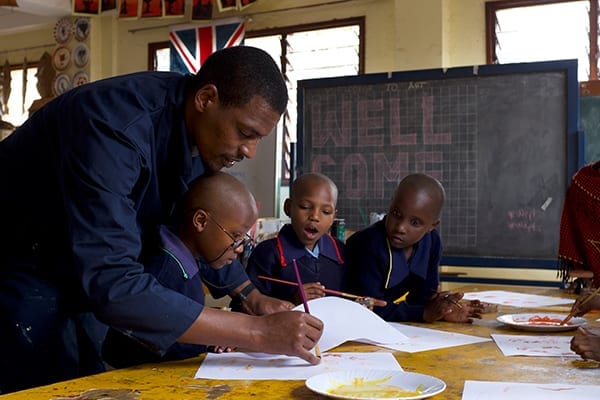
“Printing!”
“Pressing!”
“Stamping!”
“Yes!” says Mr Kephas triumphantly. “What do we say for great responses?”
“You are a superstar! You are a superstar!” the class say in unison to the students who gave the correct answers.
From a young age, Mr Kephas knew he wanted to be a teacher. At the age of fifteen, he began running classes for his cousins and neighbours out of his home in Mianzini, teaching not just art, but also science and mathematics.
He has now been working at St Jude’s for seven years, having first heard about the school from one of his friends.
“I come from a poor background,” Mr Kephas shares. “So when I discovered that St Jude’s provides a free education for poor children, I knew this was a great thing.”
When Mr Kephas was a boy he would sit on the ground, using sticks to draw in the dirt, boxes to make cars, and discarded plastic bottles to build models of houses. Occasionally his mother would find paper for him to draw on.
“I express my feelings and my ideas through art,” he says.
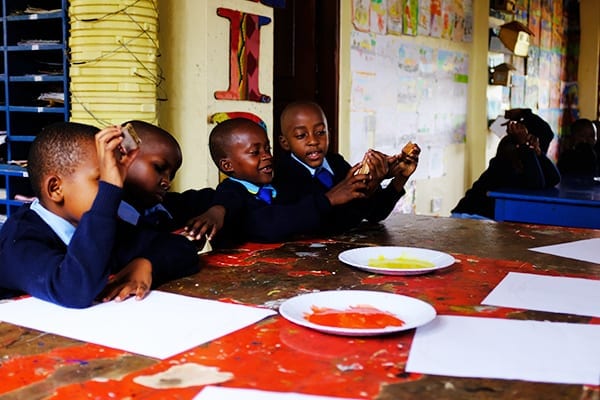
This is an idea Mr Kephas aims to extend to his students, by providing a sense of belonging in the classroom.
“What they do is what I display in the art room,” he says. “It’s not what I do. It will help them feel that this is the place where they belong.”
The art room is an explosion of colour. Lining the walls are depictions of lions, elephants and rhinoceros; hanging from the ceiling are whacky designs of handbags. At the front, on the blackboard, it reads “WELCOME!” written in bright, pink chalk.
Mr Kephas distributes the paint, and hands out the stamps with carved images of echidnas, platypuses, koalas, and boomerangs, adding some Australiana to the typical Tanzanian selection.
In the corner sits a boy named Brayan. He is particularly eager and the first to begin, breathlessly covering his paper with stamps of echidnas.
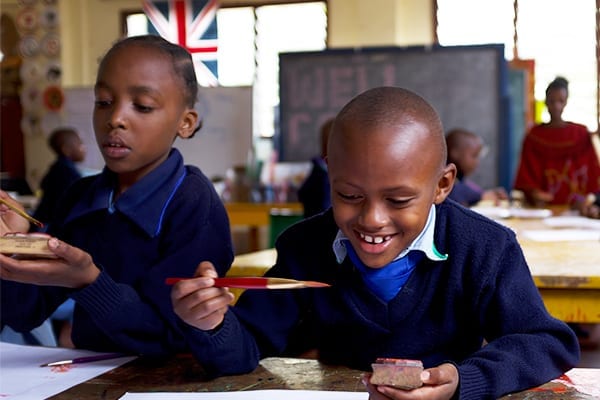
Seated next to Brayan is Magreth who has covered her paper with possums. When Magreth grows up she wants to be a teacher just like Mr Kephas. “He always makes me laugh, and I learn a lot,” she says.
Opposite Brayan and Magreth, is Isaya who is methodically working away. Isaya likes to entertain his peers by standing at the front of the class and telling them stories. Despite his storytelling skills, he aspires to be a doctor one day, “I want to help everyone!” he declares.
“Okay,” says Mr Kephas, raising his voice above the thud, thud, thud of the stamping. “Time to hold up your work!”
The children surround Mr Kephas, proudly showing off their artwork, laughing and vying for his attention.
“Today, I am impressed with all of you,” he says. “You will all get stickers. How many do you want – three?”
“Four!” cry the students. “We want four!”
Mr Kephas throws his head back, and laughs.
Without passionate, committed teachers, our students wouldn’t get the holistic, quality education they need to become the future teachers and doctors they dream of being. Your donations make this possible, donate today.
Our students and school have been beamed onto screens across Australia. St Jude’s has featured on long-running Australian news television program, Behind the News.
Australia’s national broadcaster has been running the show since the 1960’s and the segments are a part of classroom lessons for the majority of upper primary and lower secondary students in Australia. The program is also an important and accessible resource for regional students because the content is streamed online.
St Jude’s was approached to feature on the prestigious program by Producer, Emma Davis, who visited the school last year while touring Tanzania with her family.
“After seeing this side of Tanzania and Arusha, I really wanted to share that experience with people and kids back home so they can try to understand what life is like for a family on the other side of the world. At BTN we value the voice of children and work hard to give them an opportunity to share their stories from their point of view." Emma explained.
Standard 6 students were invited to audition to represent the school as ‘Rookie Reporters’. The students’ pride in their education and their English skills shone through during the process. Our Marketing team then had the hard task of selecting the two students who would help St Jude’s come to life on Australian television screens.
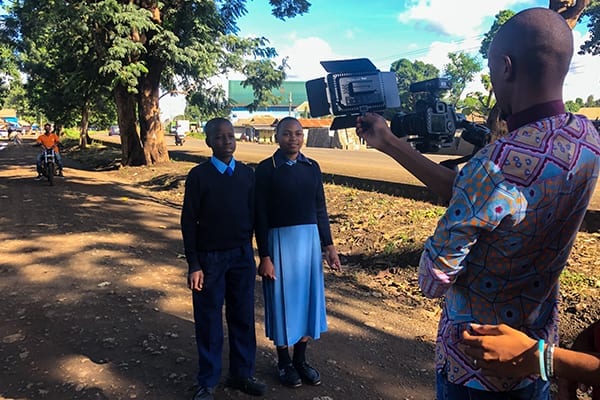
Charismatic students Abdul and Salma explained the moment they found out they were chosen to present on behalf of St Jude’s 1,800 students.
“I couldn’t believe it; I started practicing straight away. The project has really helped me become more confident,” Abdul shared.
“I hope that Australians watching the story will see the benefits of helping other people less fortunate than themselves,” Salma added.
The duo quickly became naturals in front of the camera, mentored by an experienced cameraman and journalist who are part of St Jude’s staff on the ground in Tanzania. Salma and Abdul proudly take viewers on a tour of their classrooms, library, art room and boarding house.
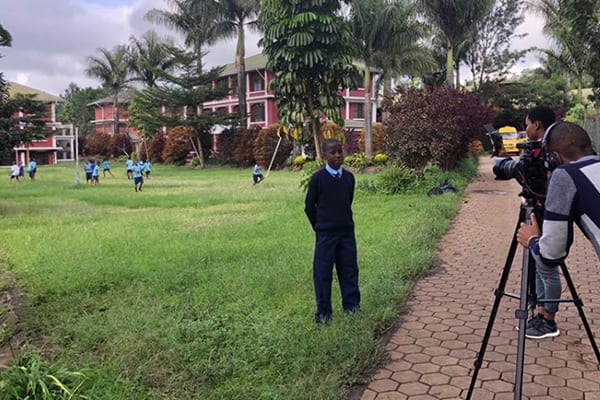
A highlight for Salma was filming with Founder Gemma Sisia, who grew up watching Behind the News at primary school herself.“I felt honoured to introduce Mama Gemma and film with her. We owe her a lot,” Salma grinned.
During the news piece, audiences were also transported to Salma’s home in the semi-rural area of Usa River to meet her mum, Saumu.
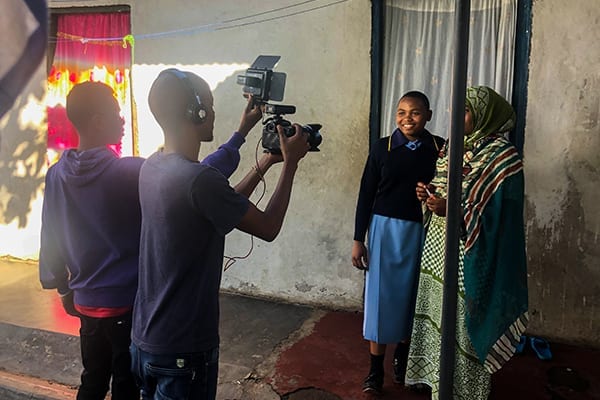
“I liked taking the team to my house and getting to introduce my Mum to Australians. She was very proud that I was selected for this project and I hope people watching feel welcomed into my home,” Salma explained.
The budding reporters hope that by sharing their lives and challenges with TV viewers it will help spread the message of how St Jude’s is really making a difference, fighting poverty through education.
“I want people watching the segment to see that our school is leading the way in Tanzania and hopefully they will think about sponsoring one of my classmates or visiting the school,” Abdul said from the heart.
The episode is being aired on Tuesday 28th May at 10am on ABC3 you can catch up on the episode on BTN’s website.
See the difference St Jude’s is making to our talented ‘Rookie Reporters’, Salma & Abdul. You can make twice the impact by donating to our appeal now.
Down a small, windy dirt road in Sakina, Arusha's booming industrial area, the buzz of machinery and the smell of fresh wood filled the air.
The latest requirement for The School of St Jude, new chapel pews, are being constructed by local carpenters employed thanks to the school's investment in the local community.
Sam's Workshop is one of the local fundis (the Swahili word for tradesmen) who benefit from the 'ripple effects' of the day to day running of St Jude's. They build and repair the hundreds of desks, benches and equipment needed to operate the primary and secondary campuses.
'By having business from St Jude's I am able to employ extra local guys and it gives us work, company owner Sam proudly said, while examining the work.
It is estimated 70% of Tanzanian's live on less than AUS$2.50 a day, meaning every job makes a difference.
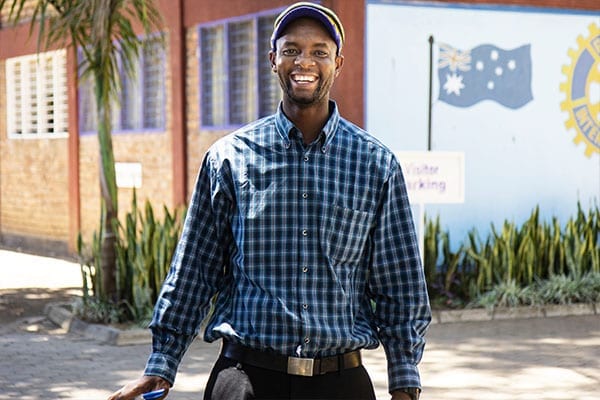
Economic Impact: Head of Maintenance and Facilities, Amani, is proud to give back to the Arusha community through local employment & investment.
Amani, Head of Maintenance and Facilities at St Jude's, explained that as the school continues to grow, so too does the positive impact on the local Arusha economy. By choosing to buy local over purchasing from a larger city like Dar es Saalam or importing from Nairobi St Jude's is ensuring that we impact many more families than just those of our students.
Last year, St Jude's injected over AUS$6 million into the East African economy, predominately in Arusha. That's made up of everything it takes to keep a school the size of St Jude's running day in and day out, from desks, books and computers to food and uniforms, right through to wages for staff.
'A lot of work goes to the local community. We pay fundis, tailors and others and we are buying materials and produce from local people. Local manufacturers and contractors are cheaper than imports because they are not including transport costs. They are thankful for the business, Amani shared with a smile.
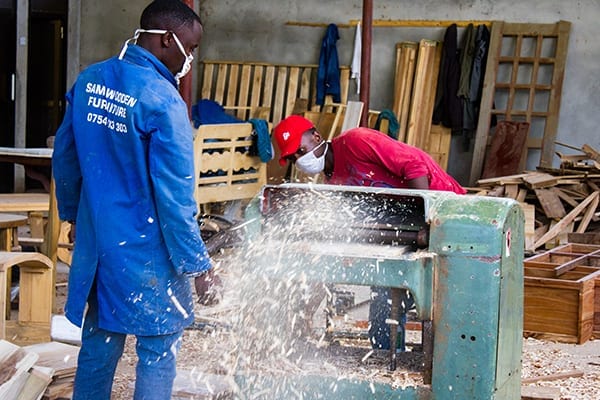
Jobs boost: Tradesman work on the school's new chapel pews at Sam's Workshop.
St Jude's is also at the heart of the community according to the swathe of farmers and shop owners who deliver produce to the school's hardworking cooks each day.
Head Chef at Moshono Primary Campus, Julius, estimated the school spends more than AUS$7,900 at the market each week, buying food needed to feed the 1,800 hungry students.
'The farmers and local shop keepers tell me regularly that they are very thankful for the existence of the school as it brings them more business. We order good quality produce to give the students nutritious foods - making sure they have fruit every day means buying over 600 bananas a day! We buy local to boost the economy of the Arusha region, he divulged while sorting tomatoes for that day's lunch.
The ripple effect continues through to Arusha's bustling central market, reaching Double Door Textiles who provide the fabrics for all the students' school uniforms.
'I love doing business with St Jude's. This year I am providing over 40 rolls of fabric just for the secondary students' school uniforms. They are one of my top clients because of the quantity required to support the school and they ask for quality material that lasts, Double Door Owner, Amer Nassor commented.

Major order: Purchasing Assistant, Grace, picks up school uniform materials from Double Door Textiles in Arusha town.
His team are hard at work sourcing materials for the influx of new Form 5 students needing uniforms in June.
'I feel very proud when I see the students in the school uniform and also when I heard the Founder, Gemma, was happy with the quality of the fabrics, Amer smiled resting on a pile of colorful textiles.
The uniform is an important part of starting school life at St Jude's, receiving it is often when it truly becomes a reality for new students that they're about to begin their journey with a prestigious school. But young students, grow and their first uniform doesn't last forever, so making the uniforms is an ongoing task.
'We purchase a huge amount of fabric so that our tailors, based at Sisia Primary Campus can produce uniforms our students can be proud to wear. Our seller has been very good to us for a very long time and we have a good relationship with him, Purchasing Assistant, Grace, explained while supervising the St Jude's tailors.
So whether it's furniture, food produce, fabrics or employing local Arushins, St Jude's is not only fighting poverty through education, but is creating a ripple effect felt well beyond the campus gates.
Fresh off running a grueling 5kms with some steep climbs and rocky terrain, Form 4 student Baraka couldn’t believe he finished in the top 30 at the international contest.
The 17-year-old proudly spoke of his Kilimanjaro Marathon run, where he was met with cheering crowds in a packed out stadium as he crossed the line in 22nd place, ahead of 678 other competitors. “It was really tough; I’ve never run such a long distance but it was a really good experience. I was able to see some of the professional athletes compete, they are very inspiring. Some of the winners even sprinted most of the way. We have been training hard but the hills and mountains today were particularly challenging,” Baraka explained, punctuated by heavy breaths.
13 secondary students from St Jude’s rose before dawn to pound the pavement, with the massive mountain making for the perfect backdrop to test their limits. Competing alongside their teachers and against the best from across Africa, their impressive results are a credit to their commitment and training.
Form 2 student Lucas crossed the line in 13th position, Baraka was the 22nd arrival and Form 1 student Jenipher secured the 31st spot.
Each student competitor credited their extensive training in the lead up to the event, where they trained for an hour a day, with no excuses!
For Form 4 student, Happiness, running 5km would have only been a dream if not for the specialised training program.
“We are used to doing smaller races, metres instead of kilometres, 100m or 200m for example. We need to work on speed more. It’s teaching us about determination and hard work,” Happiness said red-cheeked from her run.
Students also praised the adrenaline from the crowd, who cheered them through some tough conditions that even challenged the most advanced runners.
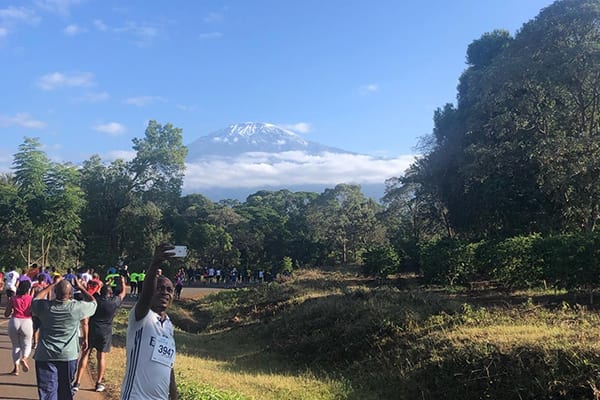
“The steep hills and mountains were definitely the hardest part. We also had to dodge a lot of runners competing over different distances but the cheering crowds made you forget about the pain,” Happiness shared.
The marathon event, which also has a 21km and 5km distance, is part of the school’s Vocational Skills program that includes athletics, basketball, football and volleyball programs run by the Vocational Skills department teachers. All are part of helping St Jude’s students achieve outside the classroom, as well as inside it.
“I really hope to continue with my running and it can complement my studies,” a beaming Baraka added.
The school’s staff also tried their luck at the brutal half marathon, completing 21kms around the base of Mount Kilimanjaro.
St Jude's Photographer, Onesmo Daniel, was amongst them and crossed the finishing line in just under three hours.
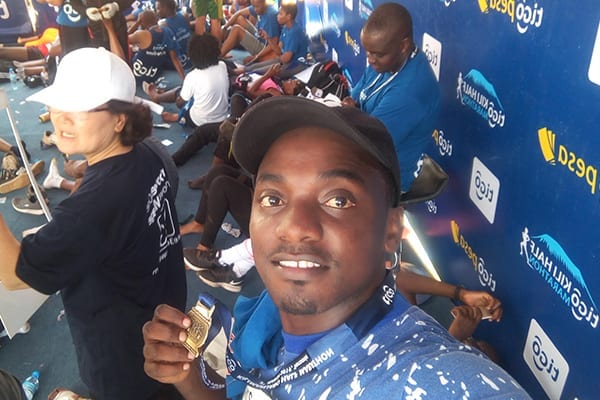
“We didn’t do as much training as last year, so I was getting a little tired, but I am proud. We actually started late so the biggest challenge was catching up to other competitors, but with my final position I overtook 1,000 people. It was so nice to see our students there and I hope next year they can run the 21kms for the extra challenge,” Onesmo smiled.
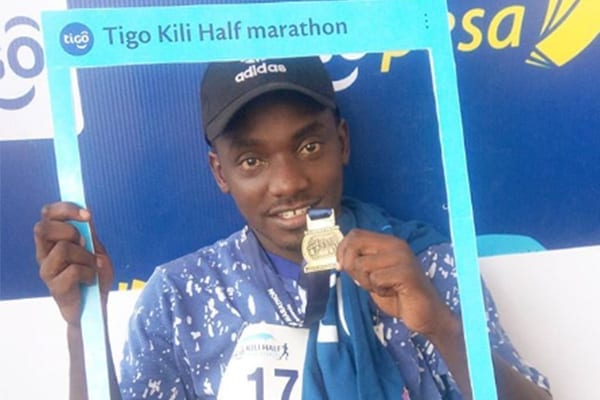
Tanzanian Athlete, Emmanuel Giniki, won the overall half marathon gold medal finishing the course in an incredible 1hr 3mins, in front of the home crowd.
But after a champion effort by our secondary students and staff, could Emmanuel have a future fierce competitor in someone from St Jude’s?
“I don’t see myself quitting my day job and becoming a professional but for the students I can see that because they are strong competitors, they have big futures ahead,” Onesmo laughed.
Thanks to the generosity of our school’s supporters, our students will continue to achieve in all kinds of arenas. You can help expand their opportunities by making a donation!